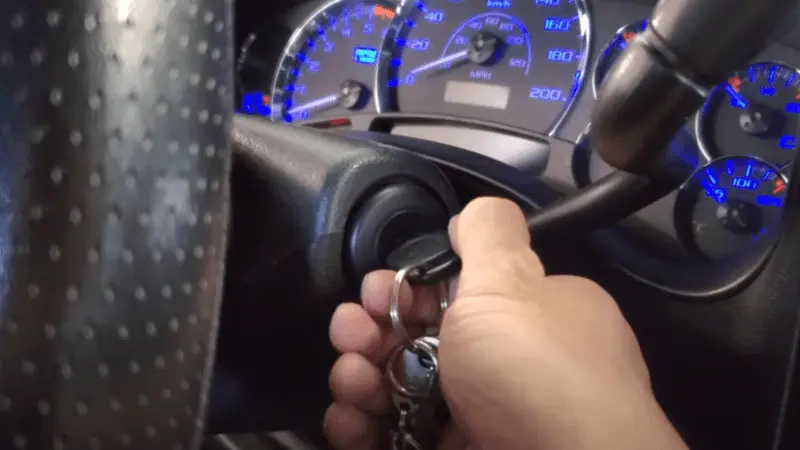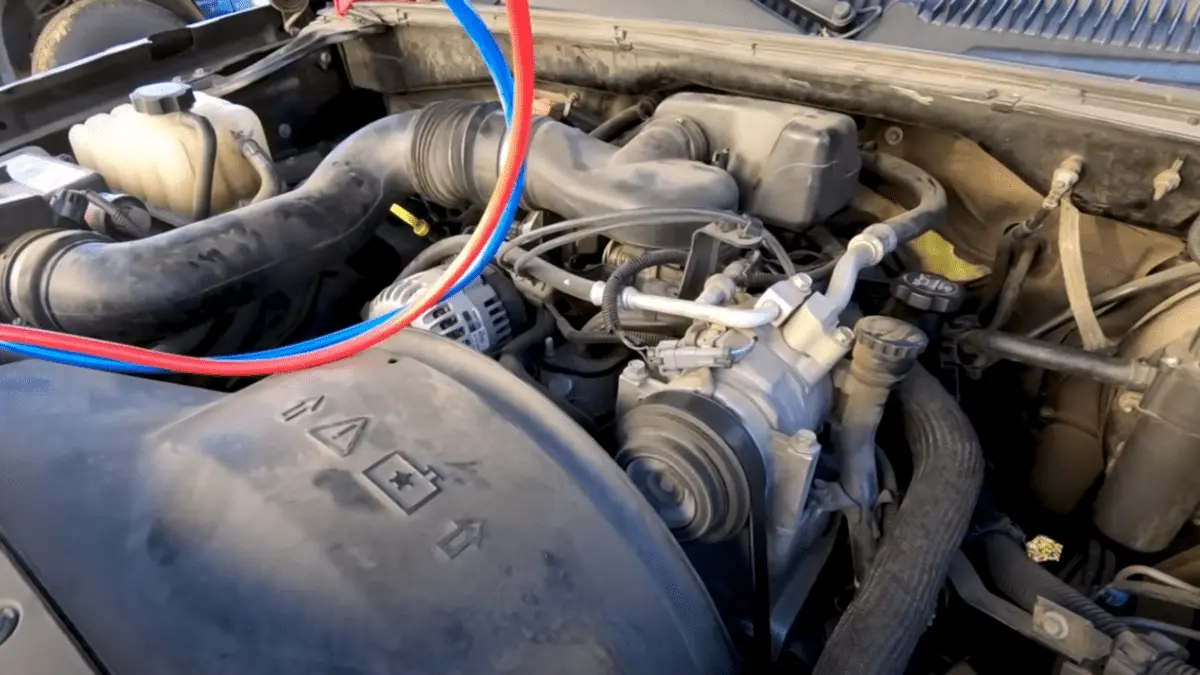The most common reason for air conditioning problems in Chevy Silverado is a malfunction in the Heating, Ventilation, and Air Conditioning (HVAC) system. When this system encounters issues, it can disrupt the comfort, efficiency, and overall driving experience that the Silverado is known for.
One simple troubleshooting step is to reset the system by removing and reinserting the HVAC/ECAS fuse, which can address minor issues. However, for more significant problems, it’s advisable to consult with a professional mechanic to diagnose and repair the HVAC system, ensuring that your Silverado remains comfortable and enjoyable to drive. Ignoring HVAC issues can lead to discomfort during extreme weather conditions and affect the truck’s overall performance.
How To Restart The Chevy Silverado’s Air Conditioning System?
A simple process can help address various cooling and heating problems in your Silverado. Here’s a step-by-step guide to restarting the HVAC system:
Step 1: Turn Off The Car

Before you start, ensure that the car is turned off. Working on the fuse box should only be done with the engine completely off to avoid any electrical mishaps.
RELATED: Chevy Silverado Shuts Off While Driving And Won’t Start
Step 2: Locate The Switch Box
The switch box for the Chevy Silverado’s HVAC system is typically located on the driver’s side, under the hood. However, it’s a good practice to consult your vehicle’s owner’s manual to confirm the exact location, as it can vary depending on the model year.
Step 3: Identify The Hvac Breaker And Remove It
Carefully locate the HVAC breaker within the switch box. You may need to refer to your owner’s manual or the fuse box diagram to ensure you’re removing the correct fuse.
Step 4: Remove The Fuse And Wait
Take out the HVAC fuse from the fuse box. When handling fuses, be extra cautious to avoid damaging them. If you have a fuse puller, it can be a useful tool for this task. After removing the fuse, wait for about 10 seconds.
Step 5: Reinsert The Fuse And Start The Car
Carefully put the HVAC fuse back into its proper place in the fuse box. Ensure it is securely seated. After reinserting the fuse, wait for approximately two minutes. This pause allows the system to reset.
Step 6: Start The Car
After the two-minute interval, start the car again. The HVAC system should now be reset, and you can test whether the issues have been resolved.
RELATED: Chevy Silverado Won’t Start After New Battery
Other Reasons & Solutions For The Air Conditioning Problems
1. Leak of Coolant
Problem: Air conditioning problems in your Chevy Silverado may be due to a coolant leak, indicating a hole in the AC system or a disconnected hose.
Solution: To address this issue, it’s essential to locate and repair the coolant leak promptly. If you need to become more experienced in automotive repair, seek the assistance of a professional mechanic to identify and fix the source of the leak. Once the leak is resolved, the AC system can be recharged to ensure it operates efficiently.
2. Defective Cooling Fans
Problem: Cooling fans are vital for circulating air within the car’s AC system. When they malfunction, it can lead to air conditioning issues.
Solution: If you know automotive repairs, you can attempt to replace the cooling fans yourself. However, if you need more confidence in your abilities, it’s advisable to consult a professional mechanic. They can diagnose the problem with the cooling fans and replace them if necessary to restore proper AC operation.
3. Electrical Problems
Problem: Electrical issues within the A/C system, such as problems with the fan, temperature control screen, or other electrical components, can disrupt the air conditioning.
Solution: In the case of suspected electrical problems, it’s best to have your Chevy Silverado assessed and repaired by a qualified mechanic. They can identify and rectify any electrical issues, ensuring that the A/C system operates correctly.
4. Failure of Blend Door Actuator
Problem: If the air temperature fluctuates uncontrollably, it may be attributed to a malfunctioning blend door actuator responsible for controlling air movement inside the car.
Solution: A faulty blend door actuator should be replaced to restore consistent and accurate temperature control. A professional mechanic best carries out this repair, as it requires precision and expertise.
5. Bad Air Pump
Problem: If none of the previous solutions work and your Chevy Silverado’s air conditioning still fails, it could indicate a malfunction in the compressor, which is responsible for cooling the air.
Solution: In the event of a non-functional compressor, it’s essential to have your vehicle inspected and repaired by a qualified mechanic. They will assess the compressor’s condition and determine whether repair or replacement is necessary to reinstate the air conditioning system’s functionality.
6. HVAC Fuse Blown
Problem: A blown HVAC fuse can disrupt the air conditioning system, causing it to malfunction.
Solution: Check the HVAC fuse for any signs of being burned out. If you find a blown fuse, replace it with a new one and attempt to activate the air conditioner again. If the issue persists, further inspection by a mechanic may be required.
7. Damaged Condenser
Problem: The condenser plays a crucial role in cooling the lines that carry the coolant. If it’s damaged, warm air may exit the vents.
Solution: If you suspect condenser damage, consult a professional mechanic to assess its condition. If the condenser is found to be damaged, it will need to be repaired or replaced to ensure proper cooling of the air within the AC system.
How To Diagnose The Chevy Silverado Air Conditioning Problems?
- Visual Inspection: Begin with a visual inspection of the HVAC system. Check for any visible damage, loose wires, or disconnected hoses. Ensure the system’s components are clean and free from obstructions.
- Review Vehicle’s Onboard Diagnostics (OBD): Many modern vehicles, including newer Chevy Silverados, are equipped with an OBD system that can identify issues within the HVAC system. If your vehicle has this feature, use it to pinpoint specific problems.
- Consult Professional Mechanic: If you don’t have access to OBD or if the issue is not apparent through visual inspection, it’s advisable to consult a qualified mechanic. They have the expertise, diagnostic tools, and experience to identify complex issues accurately.
- Communicate Symptoms: When consulting a mechanic, provide them with detailed information about the symptoms you’ve observed. Explain any unusual noises, temperature fluctuations, or performance problems related to the air conditioning system. This information can guide the diagnostic process.
- Diagnosing Multiple Factors: Keep in mind that air conditioning problems can sometimes result from multiple factors. A qualified mechanic can perform a thorough inspection to determine the primary issue and address any related problems.
- Professional Repair: Relying on a skilled mechanic ensures that the root cause of the problem is accurately identified and that the correct repair is executed. Attempting complex HVAC repairs without the necessary knowledge and tools can lead to further issues, making professional assistance a wise choice.
Frequently Asked Questions
1. Why Is My Chevy Silverado’s Air Conditioning Blowing Warm Air?
Air conditioning problems in your Silverado may result from various causes, such as a refrigerant leak, a malfunctioning compressor, or electrical issues. To pinpoint the specific issue, consult a qualified mechanic for diagnosis and repair.
2. Can I Fix Air Conditioning Problems In My Silverado On My Own?
Simple issues like changing air filters or checking fuses can be DIY tasks, but more complex problems should be left to professional mechanics. Attempting complex HVAC repairs without expertise can lead to further complications.
3. How Do I Identify If My Silverado’s Air Conditioning Has Electrical Problems?
Electrical issues can manifest as erratic temperature control, fan malfunctions, or unresponsive components. If you suspect electrical problems, consult a mechanic for a thorough diagnosis and repair.
4. What Should I Do If The Air Conditioning Is Making Unusual Noises?
Unusual noises can be a sign of a malfunctioning HVAC system. Consult a mechanic to investigate the source of the noise and address the underlying problem, which could be related to the blower motor or other components.
5. Is It Necessary To Have A Professional diagnosis for AC problems?
While DIY diagnostic tools like OBD systems can be helpful, they may not provide a comprehensive understanding of complex HVAC issues. A professional mechanic’s expertise, specialized tools, and experience are essential for accurate diagnosis and effective repairs.
Final Discussion
Addressing air conditioning problems in your Chevy Silverado is essential for maintaining a comfortable and enjoyable driving experience. These issues can be caused by a range of factors, from refrigerant leaks to electrical malfunctions, and can greatly affect your vehicle’s performance. While vehicle owners can handle some simple troubleshooting and maintenance tasks, complex problems require the expertise of a professional mechanic.
Proper diagnosis and effective repair are crucial to restoring your Silverado’s HVAC system to optimal working conditions. Attempting to fix intricate issues without the necessary knowledge and tools can result in more significant problems. So, whether it’s warm air blowing from the vents, unusual noises, or erratic temperature control, consulting a qualified mechanic is the best course of action.

Eric L. Friedman is a car expert who has worked on Chevy and GMC trucks for over 10 years. He started AutoYolo to help people fix their own cars. On the blog, he shares easy tips, step-by-step guides, and repair advice to make car problems less stressful and more affordable.

